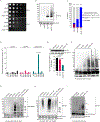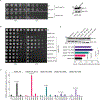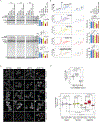K29-linked free polyubiquitin chains affect ribosome biogenesis and direct ribosomal proteins to the intranuclear quality control compartment
- PMID: 38870935
- PMCID: PMC11193623
- DOI: 10.1016/j.molcel.2024.05.018
K29-linked free polyubiquitin chains affect ribosome biogenesis and direct ribosomal proteins to the intranuclear quality control compartment
Abstract
Ribosome assembly requires precise coordination between the production and assembly of ribosomal components. Mutations in ribosomal proteins that inhibit the assembly process or ribosome function are often associated with ribosomopathies, some of which are linked to defects in proteostasis. In this study, we examine the interplay between several yeast proteostasis enzymes, including deubiquitylases (DUBs) Ubp2 and Ubp14, and E3 ligases Ufd4 and Hul5, and we explore their roles in the regulation of the cellular levels of K29-linked unanchored polyubiquitin (polyUb) chains. Accumulating K29-linked unanchored polyUb chains associate with maturing ribosomes to disrupt their assembly, activate the ribosome assembly stress response (RASTR), and lead to the sequestration of ribosomal proteins at the intranuclear quality control compartment (INQ). These findings reveal the physiological relevance of INQ and provide insights into mechanisms of cellular toxicity associated with ribosomopathies.
Keywords: DUB-E3 ligase interplay; intranuclear quality control compartment; protein aggregation; ribosome assembly stress response; ribosomopathies; ubiquitin homeostasis; unconventional K29-linked unanchored polyubiquitin chains.
Copyright © 2024 Elsevier Inc. All rights reserved.
Conflict of interest statement
Declaration of interests The authors declare no competing interests.
Figures






Update of
-
K29-linked unanchored polyubiquitin chains disrupt ribosome biogenesis and direct ribosomal proteins to the Intranuclear Quality control compartment (INQ).bioRxiv [Preprint]. 2023 May 4:2023.05.03.539259. doi: 10.1101/2023.05.03.539259. bioRxiv. 2023. Update in: Mol Cell. 2024 Jun 20;84(12):2337-2352.e9. doi: 10.1016/j.molcel.2024.05.018. PMID: 37205480 Free PMC article. Updated. Preprint.
References
MeSH terms
Substances
Grants and funding
LinkOut - more resources
Full Text Sources

